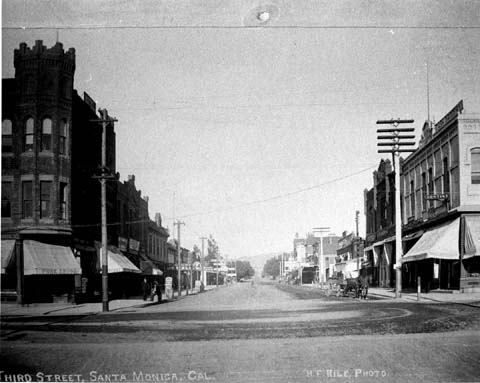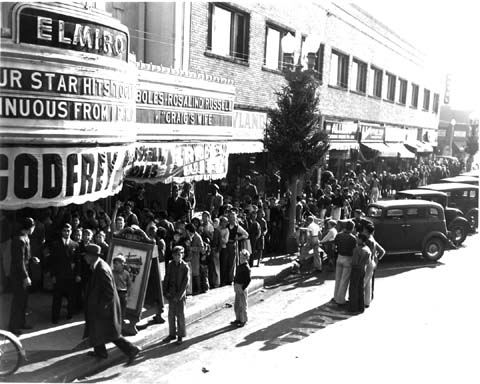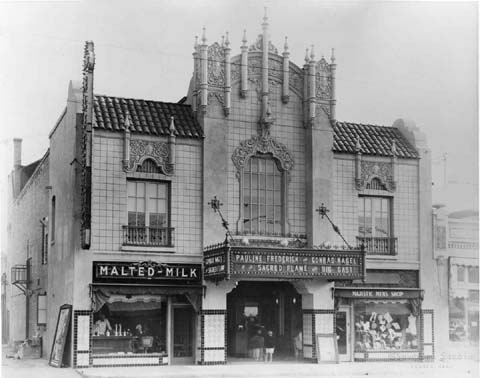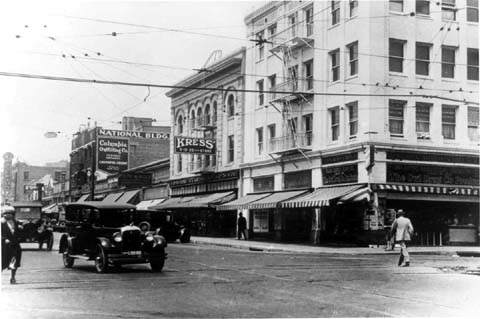|
By Jorge Casuso
April 13 -- Stand on the corner of Third Street
and Santa Monica Boulevard and, with a little help from the
Santa Monica Conservancy, turn back the clock. It’s
1929 and the jazz age is in full swing.
The Starbucks where you might have just grabbed a cup of coffee
is a brand new shoe store, its ornamental façade exuding
the optimistic energy sweeping the country. Next door, where
diners are being seated at Trastevere, the Bank of Italy is
helping its first customers just months before the stock market
crash.
Around the corner on the boulevard, the clock on the new 12-story
Bay Cities Guaranty Building, which is currently under renovation,
is marking time, oblivious that the bank that built the city’s
first true skyscraper would go belly up just months after
it opened.
 |
| Third Street looking
north from Broadway. The Keller building is to the left.
The building to the right currently houses the Broadway
Deli. (Photos courtesy of the Santa Monica Historical
Society Museum.) |
“A lot of the city’s history is embodied here,”
said Carol Lemlein, a conservancy member who helped organize
an ongoing tour of the Downtown. “People don’t
know it. They grumble about chain stores and don’t know
this is a place where a significant amount of our history
is captured.”
Today, record crowds stroll the wildly successful Third Street
Promenade, soaking in the street performances, grabbing a
bite to eat, shopping for the latest fashions or catching
the new hit movie – all the while oblivious to the wealth
of history and architecture they are passing by.
As Downtown visitors rush to their next stop, the conservancy
would like them to stop and take time to look at the ornamental
leaves and flowers, scrolls and arcs that grace the Starbucks
building. Or imagine for a moment the stars of the silver
screen lounging on the top floor of the Hotel Carmel as gambling
boats drift in the distance.
 |
| The El Miro Theater
on Third Street opened in 1938. Only the facade was left
standing after the building was razed in the late 80s
and replaced with the Cineplex Broadway 4 Theatre. |
The Downtown tour, which will kick off for the public this
month, has been a labor of love for conservancy members Lemlein
and Ruthann Leherer, who is a member of the City’s Landmarks
Commission.
For months, along with a small army of volunteers, Lemlein
and Leherer combed the City records for historic buildings
that could be showcased in the conservancy’s first ongoing
tour.
“We wanted to focus on landmarks and interesting, but
less appreciated buildings,” said Lemlein, an architecture
buff who volunteered with the conservancy after retiring from
her high tech job during the dot.com bust.
Conservancy volunteers consulted the City’s inventory
of older buildings and studied the historic preservation section
of the City Plan. They took a tour led by conservancy member
Nina Fresco, who chairs the Landmarks Commission and had put
together a booklet of historic buildings.
After narrowing the field of candidates, the conservancy members
visited the County Assessors Office, where they poured through
handwritten property records in the basement of its administration
building in Downtown LA.
“Some of the records are deteriorating beyond recognition,”
said Lemlein. “Sometimes you can’t find them.”
 |
| The Majestic, now the
Mayfair Theater, was battered by the 1994 Northridge earthquake.
Its proposed redevelopment will preserve the facade. |
The volunteers also pored over permit records at Santa Monica
City Hall and old phone books at the Main Library. And they
solicited help from the Santa Monica
Historical Society, which designated a volunteer to help with
the historical research and provided access to its vast photo
collection.
To round out the research, volunteers viewed microfiche copies
at the library of old issues of the Evening Outlook,
the city’s defunct daily paper, and visited the LA Library
to check old microfiche copies of the Los Angeles Times.
“Some of it is in horrible condition,” Lemlein
said.
“We didn’t lack for material,” she added,
“and we had several people from the conservancy collecting
info that we compiled into a handbook.”
To print the handbook and market the tour, the conservancy,
with “a lot of advice” from its older LA counterpart,
lobbied the City for money. After six months of work, the
group secured $10,500 to cover the graphic design and printing
costs.
The conservancy is now working with the Santa Monica Convention
and Visitors Bureau and “sales people at local hotels”
to market the tours, Lemlein said.
“We’re developing a brochure to offer hotels and
announcing it in a wide variety of media,” she said.
“Our plan is to really launch the marketing program
in the middle of April.”
The tour is not only a stroll through the past for first-time
visitors, it offers residents who have walked the Downtown
streets countless times a lens with which to view the present.
Those who complain about chain stores taking over the popular
shopping strip may be interested to learn that three national
retailers built stores on the same block of the Promenade
over the course of a quarter century.
 |
| Northeast corner of
Third Street and Santa Monica Boulevard. Building to the
right currently houses The Gap. The Kress building next
door is home to the Bayside District Corporation offices. |
In 1924, the Kress Company built a store in the Classical
revival style that is currently home to Barney’s Beanery
and the Bayside District offices. Across the street, W.T.
Grant opened shop in 1936, constructing a building in the
late Art Deco phase known as Classical Moderne. While Woolworth
built the last variety store on the Promenade in 1949.
The rows of apartment buildings that continue to go up on
5th, 6th and 7th streets Downtown are not the first efforts
to bring residents to the city’s central core. The Mar
Vista Apartments at the corner of Arizona and Second was originally
an apartment hotel.
In fact, the open courtyard and wide window expanses that
provide plenty of light and air are the sort of design City
officials are currently pushing.
Mixed-use buildings with affordable housing, something City
Hall is strongly encouraging, are also a blast from the past.
The Lido Hotel Apartments on the corner of Broadway and 4th
Street marked the eastward expansion of the Downtown when
the Art Deco brick building replaced wood frame houses in
1931.
The building features Egyptian-inspired accents that were
all the craze after the discovery of King Tut’s tomb
in 1922. Down the block, on the southeast corner of 4th and
Broadway, another building boasts close ties to an American
cultural icon – Popeye – who was created inside
the Builders Exchange.
The 1927 building was one of the structures that benefited
from the 1994 Northridge earthquake that shook the seaside
city. The temblor spurred the restoration of the Spanish Baroque
influenced structure, which features ornaments woven into
the design and highly intricate wrought iron grills.
Bayside and City officials have been encouraging building
owners renovating their Downtown properties to remove additions
that hid some of the original features, Lemlein said.
“Thanks in part to the leadership of the Bayside,”
she said, “a lot of the historic facades covered in
the 1960s to make it more modern have been uncovered.”
While the earthquake helped shake off some modern additions,
it also marked the end of at least one historic structure
– the Henshey’s department store built at the
corner of 4th and Santa Monica Boulevard in 1925. A new building
on the site currently houses the sporting goods retailer REI.
Other buildings have long been lost. All that remains of the
old City Hall built in 1903 at the northwest corner of 4th
and Santa Monica Boulevard is its colorful past immortalized
in Raymond Chandler’s “Farewell My Lovely”
as the site of the police commissioner’s office.
The site – recently developed with apartments above
ground-floor retail – was once home to the Santa Monica
jail, known as the “black hole of Calcutta,” which
was the subject of a grand jury investigation.
 |
| The Rapp Saloon (small
building to the left) still stands on Second Street. The
Vitagraph, one of the first companies to produce motion
pictures, opened a studio in Santa Monica in 1913. |
While much of Downtown’s physical history has been
lost, the Rapp Saloon, built when the City was founded in
1875, still stands on Second Street, a small brick box dwarfed
by a cluster of buildings that house the local youth hostel.
It was here that studio workers and actors came to drink Los
Angeles brewed beer when Santa Monica was home to silent movie
studios. And with Santa Monica once again a hub for the entertainment
industry, the remnants of its colorful past can still come
alive with a little imagination and some help from the conservancy.
For more information on the Santa Monica Conservancy visit
www.smconservancy.org
or call 310.496.3146.
|